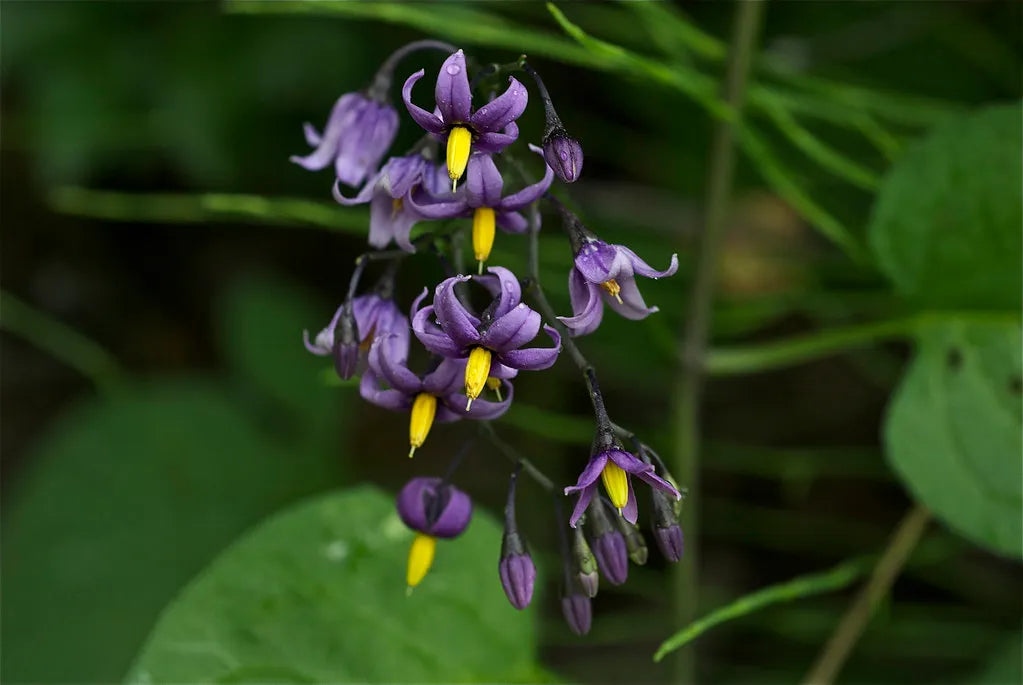
October: Woody Nightshade
 History:
History:
Spells and Potions
As a well known symbol of Halloween and witchcraft, nightshade has a deep history around the world spanning from indigenous medicine to evil-eye wards. In Europe, legend says that witches would use the plant’s toxins to create potions and ointments to enable them to fly. It was believed that finding bittersweet nightshade growing near the home was a strong omen of change: either good or bad. Some people would leave bittersweet nightshade wreaths on their doors to guard against magic and witches. They would even weave the vine into necklaces for their cattle so that they couldn’t be stolen and bewitched. Sachets of the dried leaves and berries were sometimes places under pillows to help heal a broken heart, ward off nightmares, and protect them from the evil eye. During the European Renaissance, the berries were used as a dye, producing vibrant shades of red and purple.
Apart from European folklore, the ancient Greeks believed that woody nightshade came from the sorceress Circe who would use the berries in potions that would transform her enemies into animals. Similarly, the Romans thought the flowers had magical properties and were used in rituals and spells.
Some Native American tribes used the plant for medicinal purposes despite its toxicity. It was use to relieve skin irritations and some respiratory problems. We now know through various studies that it does actually hold a lot of merit in pain relief treatments.
Medicine
Woody nightshade is very toxic, and ingesting any part of the plant can lead to vomiting or abdominal pain, and in large amounts it can lead to brain failure or coma. This type of nightshade contains the alkaloid “solanine” which acts narcotically. In large doses, solanine paralyses the central nervous system, which can manifest as confusion, hallucinations, seizures, and coma. But don’t get too panicked, it takes a very very large dose to get such extreme effects, and usually cases are treated far before they become that serious. It is important to note that some people have skin sensitivity to the plant and can cause inflammation. This shouldn’t deter you from using this plant as a garden accent, but is important when thinking about what children or pets might be interacting with your space.
On the brighter side, herbal medicine has suggested using parts of the bittersweet nightshade plant for therapeutic benefits. The leaves and roots are used as a diuretic or purging agent in very small quantities. Many pharmacological studies are being done to isolate the compounds which seem to aid in rheumatoid arthritis to create new medicines with the plant.
Like all things, please don’t try to make your own potions and medicines at home from this plant unless you are a trained professional or have gotten guidance from one. In this day and age, we often forget that our bodies can be humbled by the natural world and we are not immune to nature.
Cultivation + Fun Facts
Bittersweet nightshade has been labeled an invasive species in the United States and parts of North America. It can grow rapidly, stealing nutrients and light from other plants that it might twine around while growing. That being said, it also is an important part of the natural ecosystem. Though toxic to mammals, birds rely on the plant’s bright red berries to sustain them into the colder season. Dense mats of the vines can provide as homes for small animals like chipmunks or rats.
 Woody Nightshade Berries are a bright red while Deadly Nightshade (Belladonna) berries are deep black. That is the easiest way to spot this species’ more vicious neurotoxic cousin.
Woody Nightshade Berries are a bright red while Deadly Nightshade (Belladonna) berries are deep black. That is the easiest way to spot this species’ more vicious neurotoxic cousin.
Curious to learn more? Checkout these sources!